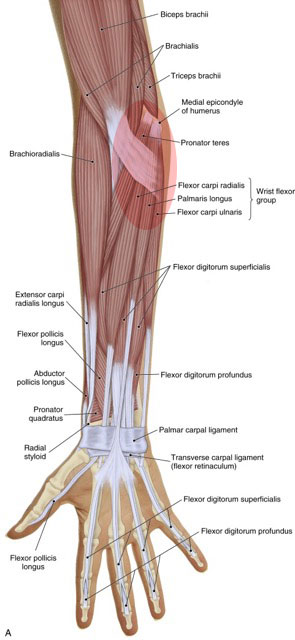Signs and Symptoms:

Golfer’s elbow involves pain at the common flexor belly/tendon and the medial epicondyle of the humerus. Permission: Joseph E. Muscolino, The Muscle and Bone Palpation Manual (2016), Elsevier.
The most common symptoms of golfer’s elbow are pain and tightness at the common flexor belly/tendon. This tightness might be global tightness of the entire belly or bellies of the associated muscles, or might manifest as myofascial trigger points (TrPs). The pain will usually occur with contraction of the muscles of the common flexor tendon, whether it is concentric, eccentric, or isometric contraction. Pain as well as tightness will also be evident with palpation of the proximal bellies of the associated musculature and their proximal common flexor tendon. Pain might also occur when the muscles of the common flexor tendon are stretched; this would occur when the hands and/or fingers are actively or passively moved into extension. If the tightness of the musculature of the common flexor tendon is severe enough, it might also cause decreased active or passive extension range of motion of the hand at the wrist joint.
Continuing overuse of flexor muscles will cause a constant pulling on the medial epicondyle of the humerus via the common flexor tendon. This will eventually lead to irritation, swelling, and therefore pain at the periosteum of the medial epicondyle. Therefore, even though golfer’s elbow is technically named for the medial epicondylar attachment, as with tennis elbow, pain at the epicondyle itself does not usually occur until this condition has progressed to be more chronic and severe.
In addition to pain, the early stages of golfer’s elbow also involve swelling at the common flexor belly/tendon. The swelling can also spread to the medial epicondyle (hence the term medial epicondylitis). In later stages of this condition, usually after a period of approximately six months or more, the swelling gradually recedes and degeneration of the collagen construct of the common tendon occurs (hence the term medial epicondylosis). Due to the degeneration of the tendon and the continued pull of muscular contraction, tearing of the tendon may also occur.
If golfer’s elbow is left unresolved for a very long time, because its underlying cause is overuse and irritation of the flexor musculature of the anterior forearm, tendinitis of the distal tendons of these muscles at the wrist joint is a possible consequence. Also, overuse of finger flexors will likely precipitate tennis elbow as well (because finger flexion to grip an object requires isometric contraction of the wrist extensor musculature to stabilize the wrist joint as the object is gripped).


